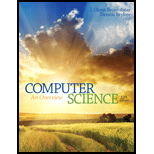
Concept explainers
Design a recursive version of the Euclidean
Question 3 of Section 5.2:
3 The Euclidean algorithm finds the greatest common divisor of two positive integers X and Y by the following process:
As long as the value of neither X nor Y is zero, assign the larger the remainder of dividing the larger by the smaller. The greatest common divisor, if it exists, will be the remaining non-zero value.
Want to see the full answer?
Check out a sample textbook solution
Chapter 5 Solutions
Computer Science: An Overview (12th Edition)
Additional Engineering Textbook Solutions
Java How to Program, Early Objects (11th Edition) (Deitel: How to Program)
Using MIS (10th Edition)
Digital Fundamentals (11th Edition)
Modern Database Management
Starting Out with C++ from Control Structures to Objects (8th Edition)
Introduction to Programming Using Visual Basic (10th Edition)
- Algorithm problem w/ recurrence: Frying pancakes: a small pan can only hold two pancakes at a time. Each pancake needs to be fried on both sides. Frying one side takes 1 minute, no matter how many pancakes are on the pan. Consider this recursive algorithm: If n <= 2, fry the pancakes or the two pancakes together on each side. If n > 2, fry any two pancakes together on each side and then apply the same process recursively to the remaining n-2 pancakes. a. Set up and solve the recurrence for the amount of time this algorithm needs to fry n pancakes. b. Explain why this algorithm does not fry the pancakes in the minimum time for all n > 0. c. Give a correct recursive algorithm that executes the task in the minimum amount of time. > I was not sure how to start this. I have had trouble with recurrence in the past. Also from the work that I did do, I didn't know how there could be a better algorithm. Thanks in advancearrow_forwardComputer Science A set M is defined recursively by: 2 and 3 belong to M If x and y belong to M then so does x·y Which of the following numbers belong to M if x≠y?arrow_forward8. Ackerman's Function Ackermann's Function is a recursive mathematical algorithm that can be used to test how well a system optimizes its performance of recursion. Design a function ackermann(m, n), which solves Ackermann's function. Use the following logic in your function: If m = 0 then return n + 1 If n = 0 then return ackermann(m-1,1) Otherwise, return ackermann(m-1,ackermann(m,n-1)) Once you've designed yyour function, test it by calling it with small values for m and n. Use Python.arrow_forward
- For funX |C Solved xb Answer x+ CodeW X https://codeworko... 田) CodeWorkout X267: Recursion Programming Exercise: Cumulative Sum For function sumtok, write the missing recursive call. This function returns the sum of the values from1 to k. Examples: sumtok(5) -> 15 Your Answer: 1 public int sumtok(int k) { 2. } (0 => ) return 0; 3. } else { return > 6. { Check my answer! Reset Next exercise 1:09 AMarrow_forwardThe Tower of Hanoi is a puzzle where n disks of different sizes arestacked in ascending order on one rod and there are two other rods with nodisks on them. The objective is to move all disks from the first rod to thethird, such that:- only one disk is moved at a time- a larger disk can never be placed on top of a smaller oneWrite a recursive function that outputs the sequence of steps needed tosolve the puzzle with n disks.Write a test program in C++ that allows the user to input number of disks andthen uses your function to output the steps needed to solve the puzzle.Hint: If you could move up n−1 of the disks from the first post to thethird post using the second post as a spare, the last disk could be moved fromthe first post to the second post. Then by using the same technique you canmove the n−1 disks from the third post to the second post, using the firstdisk as a spare. There! You have the puzzle solved. You only have to decidewhat the nonrecursive case is, what the recursive…arrow_forwardAny problem that can be solved recursively can also be solved with a .arrow_forward
 C++ Programming: From Problem Analysis to Program...Computer ScienceISBN:9781337102087Author:D. S. MalikPublisher:Cengage Learning
C++ Programming: From Problem Analysis to Program...Computer ScienceISBN:9781337102087Author:D. S. MalikPublisher:Cengage Learning
